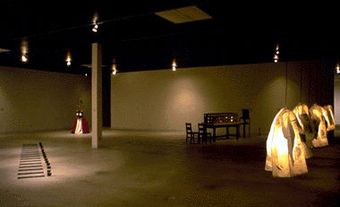The Art Gallery of Ontario, founded in 1900 as the Art Museum of Toronto, became the Art Gallery of Toronto in 1919 and in 1966 - reflecting an expanded role in the province - the Art Gallery of Ontario. The permanent collection comprises more than 79 000 works representing nearly 2000 years of extraordinary European, Canadian, modern and contemporary art - paintings by such masters as Rembrandt, Hals, Poussin, Chardin, Delacroix, Renoir and Picasso, and sculptures by Rodin, Degas and Matisse. The gallery's Henry Moore Sculpture Centre holds the world's largest and most comprehensive public collection of Moore works anywhere. An expansion in 1993 facilitated the construction of permanent displays of Inuit and contemporary art and a Print and Drawing Study Centre. More recent additions include significant collections of African and Oceanic art, as well as an expansion of the photography collection. A substantial part of the permanent collection is the work of Canadian artists dating from the 18th century to the present day. The gallery averages about 20 special exhibitions each year. Major international shows in recent years have included "The Barnes Exhibit" (1994), "The Courtauld Collection" (1998), "Treasures from the Hermitage Museum: Rubens and His Age" (2001), "Gauguin to Matisse: French Masterpieces from the Hermitage Museum" (2002), "Turner, Whistler, Monet: Impressionist Visions" (2004) and "Catherine the Great: Arts for the Empire - Masterpieces from the Hermitage Museum, Russia" (2005). Recent landmark exhibitions of Canadian art include "Krieghoff: Images of Canada" (1999), "Tom Thomson" (2002) and "Emily Carr: New Perspectives on a Canadian Icon" (2007).
Lectures, films, tours and concerts are regularly scheduled. In the Off the Wall! Centre, children and adults enjoy art-related activities or take classes in the Gallery School. The E. P. Taylor Research Library & Archives is an invaluable information centre for researchers, art historians and students. The original gallery home, The Grange, is a restored Georgian mansion and a museum of life in Upper Canada in the 1830s. Reaching into communities across Ontario and Canada, the museum offers touring exhibitions and studio programs.
The gallery's collection, facilities and programs have attracted a strong membership of 40 000, the largest per capita in North America. In 2009/10, total attendance at the gallery was a record-breaking 78 500 visitors. The AGO is partially funded by the Ontario Ministry of Culture. Additional operating support is received from the volunteers of the AGO, the City of Toronto, the Department of Canadian Heritage and the Canada Council for the Arts. Additional revenues are earned from membership support, program fees, a retail shop, a food and beverage operation and by private gifts and corporate donations and sponsorships. All works of art in the collection have either been donated or have been purchased with income from donations.
In November 2002, the AGO announced the details of a major transformation project that included an unprecedented donation of art and funding by businessman Kenneth Thomson and a physical redesign and expansion led by architect Frank Gehry.
Included in Thomson's donation were over 2000 artworks, featuring paintings by Canadian artists Paul Kane, Tom Thomson, Cornelius Krieghoff and Lawren Harris along with a large number of rare European art objects dating from the Middle Ages to the mid-nineteenth century. In addition, Thomson provided $50 million in capital funding for the museum's expansion, plus a further commitment of $20 million in endowment funding.
The Frank Gehry renovation, costing $276 million, opened to the public on 14 Nov 2008. The new building was designed, in part, to showcase the Thomson bequest and more than doubled the exhibition space, providing more room for the museum's collections of Canadian and international art. Gehry, whose accomplishments include such landmark buildings as the Guggenheim Bilbao in Bilbao, Spain, and Los Angeles' Walt Disney Concert Hall, drew on his childhood affection for the original AGO building to create an addition that was sympathetic to the original structure and at the same time incorporated innovative design features. These include a dramatic wooden staircase facing the main entryway and a glass gallery stretching the length of the north side of the building that creates an interesting interaction with the Victorian-era homes that line the street.
See also Toronto Feature: The Grange.
See also Toronto Feature: Art Gallery of Ontario.

 Share on Facebook
Share on Facebook Share on X
Share on X Share by Email
Share by Email Share on Google Classroom
Share on Google Classroom














